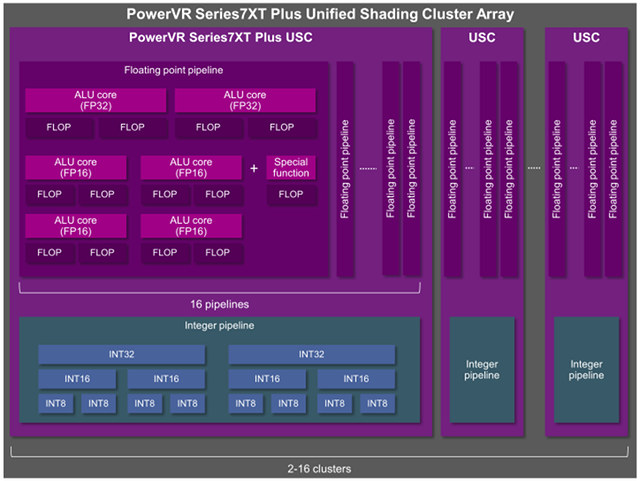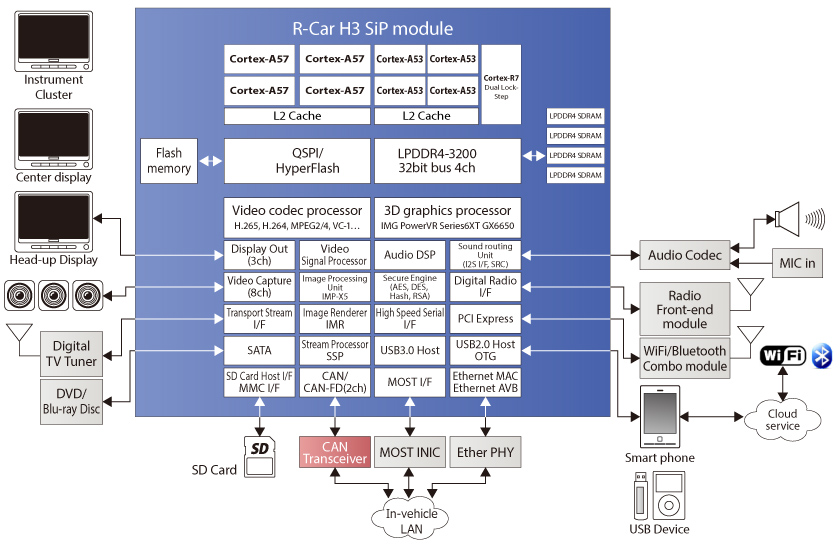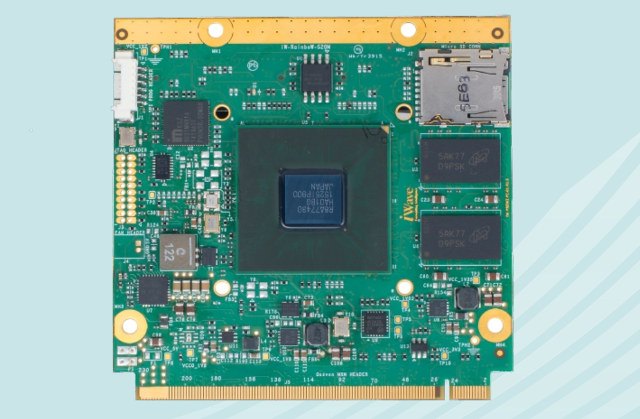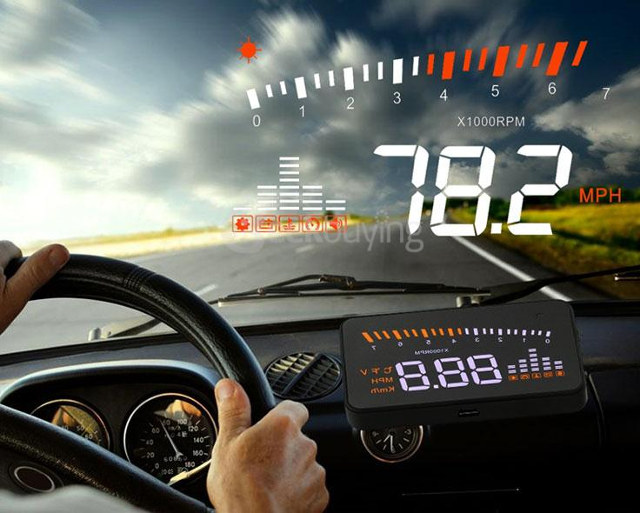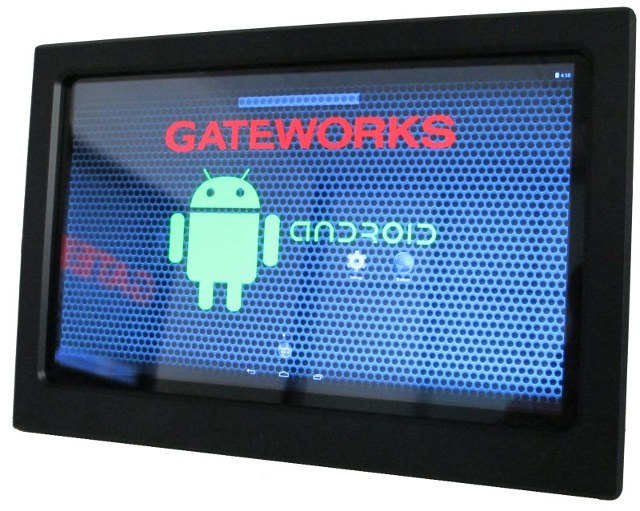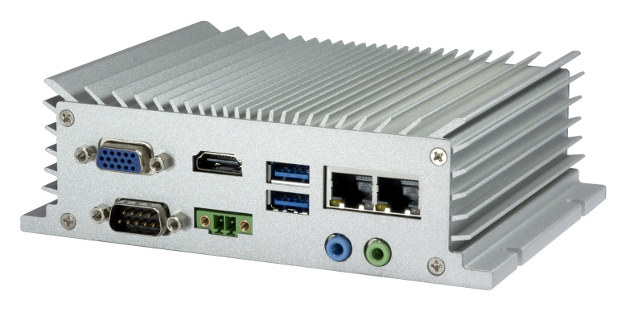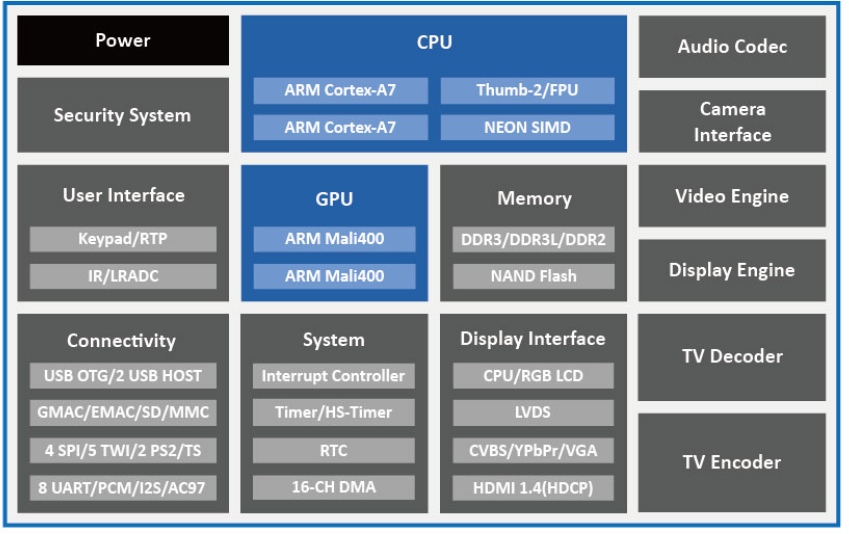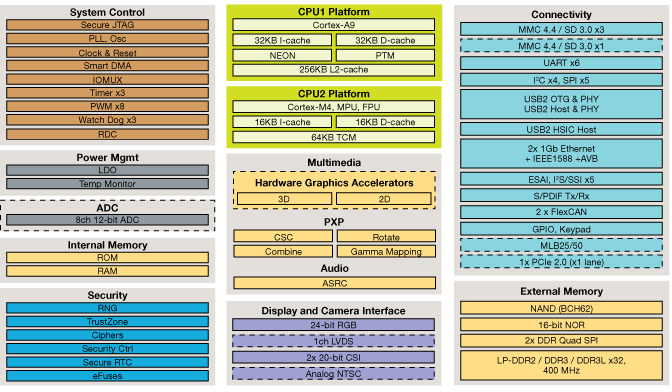Imagination Technologies introduced PowerVR Series7XT GPU family with up to 512 cores at the end of 2014, and at CES 2016, they’ve announced Series7XT Plus family with GT7200 Plus and GT7400 Plus GPUs, with many of the same features of Series7XT family, plus the addition of OpenCL 2.0 API support, and improvements for computer vision with a new Image Processing Data Master, and support for 8-bit and 16-bit integer data paths, instead of just 32-bit in the previous generation, for example leading to up to 4 times more performance for applications, e.g. deep learning, leveraging OpenVX computer vision API. GT7200 Plus GPU features 64 ALU cores in two clusters, and GT7400 Plus 128 ALU cores in a quad-cluster configuration. Beside OpenCL2.0, and improvements for computer vision, they still support OpenGL ES 3.2, Vulkan, hardware virtualization, advanced security, and more. The company has also made some microarchitectural enhancements to improve performance […]
Renesas R-Car H3 Deca-Core Processor and Driverless Car Roadmap
Renesas has recently unveiled R-Car H3 deca-core processor for automotive applications with four Cortex A57 cores, four Cortex A5 cores, and two Cortex-R7 “dual-lock step” cores for real-time processor, and has part the releases showed the expected roadmap for the implementation of driverless / autonomous cars. Let’s start with the processor (R8A77950) and SiP module (R8J77950) specifications: CPU cores – quad core ARM Cortex-A57, quad core ARM Cortex-A53, and dual lock-step ARM Cortex-R7 cores with respectively 48KB/32KB, 32KB/32KB, and 32KB/32KB L1 instructions/operand cache. GPU – IMG PowerVR Series6XT GX6650 External memory – LPDDR4-SDRAM up to 1600 MHz, data bus width: 32 bits x 4 ch (12.8GB/s x 4) Expansion bus – 2 ch PCI Express2.0 (1 lane) Video Out – 3x display output Input / camera – 8x video inputs Video codec module (H.265, H.264/AVC, MPEG-4, VC-1, etc.) IP conversion module 2x TS Interfaces Stream and Security Processor Video image […]
iWave Systems iW-RainboW-G20M-Q7 SoM Features Renesas RZ/G1M Cortex A15 SoC
iWave Systems has unveiled a new Qseven 2.0 compliant system-on-module part of their RainboW family with iW-RainboW-G20M-Q7 module powered by Renesas RZ/G1M dual core ARM Cortex A15 SoC, and targeting industrial and automotive applications with over 10 years of support. iW-RainboW-G20M-Q7 module specifications: SoC – Renesas RZ/G1M dual core ARM Cortex A15 @ 1.5GHz with PowerVR SGX544MP2 GPU @ 520MHz System Memory – 1GB DDR3(expandable) Storage – 4GB eMMC Flash (expandable) + 2MB SPI NOR Flash for boot code, and optional Micro SD Slot Connectivity – 1x Gigabit Ethernet PHY USB – 2 Port USB HUB I/Os via 230-pin Qseven edge connector: Storage – 1x SATA , 1x SDHC USB – 1x USB3.0 host, 2x USB 2.0 hosts, or 1x USB 2.0 device Display – 1x LVDS Connectivity – 1x Gigabit Ethernet Audio – 1x I2S Audio 2x PWM, 2x I2C, SPI, CAN, UART, GPIOs 1x PCIe (multiplexed with SATA) JTAG or […]
X5 ODB-II Head Up Display Shows Vehicle & Engine Speed, Fuel Consumption, and More on Your Windscreen
OBDII adapters have been around for a while. You simply attach it to the OBDII (aka OBD2) diagnostic connector of your car to get data such as engine’s RPM, vehicle’s speed, and failure logs over Bluetooth or USB onto your smartphone with apps such as Torque Lite. X5 ODB-II head up display uses the same technology but instead of displaying data your mobile’s screen, it shows it on the windscreen. Some of X5 OBD2 HUD specifications and features: Display – 3″ display with manual and automatic brightness adjustment Vehicle interface – OBDII or EU OBD Displayed Parameters / Alarms – Vehicle speed (Km/h or M/h), engine speed (RPM), low voltage alarm, high temperature alarm (C or F), speed alarm, fuel consumption Dimensions – 9 x 5.4 x 1.2 cm Weight – 38 grams The device comes with an OBD-II Cable, and anti-skid mat, and a reflective film to work around […]
Gateworks Introduces an Embedded Android LCD Touchscreen Development Kit
Gateworks has launched a rugged touchscreen LCD devkit featuring one of their Freescale i.MX6 based Ventana SBC, namely Ventana GW5224, that is similar to Ventana GW5220, but with a quad core Freescale i.MX 6Quad instead of the i.MX 6Dual found in the latter. GW11036 Embedded Android Development Kit features and specifications: GW5224 single board computer SoC- Freescale i.MX6 Quad with 4x Cortex A9 core @ 1GHz and Vivante GPU (automotive grade: -40 to +125C) System Memory – 1GB DDR3-800 SDRAM Storage – 2GB Flash, micro SD slot, serial configuration EEPROM Connectivity – 1x Gigabit Ethernet port (RJ45) Video Output and Input – HDMI 1.4 out, LVDS output, 3x analog composite video inputs Audio – HDMI, analog stereo Line In/Out Expansion – 2x Mini PCIe sockets including one with PCIe signalling Other I/O ports: Serial – 2x RS232, CAN Bus 2.0B @ 1 Mbps Master/slave SPI, GPIO USB – 1x USB […]
VIA Introduces AMOS-3005 Fanless Rugged Computer with Eden X4 x86 Processor, and VX11 Media Processor
VIA Embedded Store has just sent a newsletter to announce the launch of the company’s latest rugged embedded computer, AMOS-3005, powered by VIA Eden X4 processor and VX11 media processor and chipset, supporting temperature ranges from -10°C to 60°C, and featuring a flexible 9V-36V DC input. AMOS-3005 specifications: Processor – VIA Eden X4 quad core 64-bit x86 processor @ 1.2 GHz (NanoBGA2 package) with 2MB L2 cache, 1066 MHz front side bus Chipset – VIA VX11 Media System Processor with an integrated VIA Chrome 640/645 graphics processor supporting DirectX 11, and OpenCL, as well as a VIA ChromotionHD 5.0 video engine supporting dual 1080p HD decoding of H.264, MPEG-2, WMV9, and VC-1 codecs. System Memory – 1x DDR3 1333 SDRAM SODIMM socket (Up to 8GB memory size) Storage – 1x mSATA slot, 32Mbit Flash memory for AMI BIOS. Video Output- 1x HDMI, 1x VGA up to 2048×1536, with dual independent […]
Allwinner T2 Dual Core Processor is Made for Automotive Infotainment and Navigation
Allwinner already has several processor families, the most famous being the A-series for tablets, followed bythe H-series for home entertainment, the V-series for video application, the R-series for IoT as found in R8 module used in C.H.I.P $9 computer, and now I’ve just found out the company launched T-series with Allwinner T2 and T8 for “Transportation”/automotive applications. I don’t have any details about T8 processor, but the company kindly shared a product brief with the specs for Allwinner T2: CPU – Dual core Cortex A7 CPU – Mali-400MP2 supporting OpenGL ES 1.1/2.0 Memory – DDR2, DDR3, and DDR3L controller, NAND flash controller with 64-bit ECC Video Inputs – 4x AV Inputs Video – H.264 2160p video decoding, multi-format decoding, h.264 encoding @1080p30 / 720p60. Display – Multi-channel HD display with integrated HDMI 1.4 transmitter, CPU/RGB/LVDS display interface, support for VGA/CVBS/YPbPr, and integrated TV decoder. Camera – Integrated parallel 8-bit interface YUV sensor, […]
Freescale Announces i.MX 6SoloX ARM Cortex A9 & Cortex M4 Processor
Freescale i.MX6 SoloX processor started to show up in the ARM Linux Kernel mailing list last year, and Cortex A9 + Cortex M4 processor showed up in some marketing documents, but so far all documentation was tied to a non-diclosure agreement. However, all resources are now publicly available, as the company officially launched i.MX 6SoloX processor at Embedded World 2015. Freescale i.MX 6SoloX specifications: CPU – ARM Cortex-A9 up to 1 GHz with 512 KB L2 cache, 32 KB instruction and data caches and NEON SIMD media accelerator MCU – ARM Cortex-M4 up to 200 MHz with 16 KB instruction and data caches, 64 KB TCM, MPU and FPU Memory Interface 16/32-bit DDR3-800 and DDR3L-800, 16/32-bit LPDDR2-800 SLC/MLC NAND, 62-bit ECC, ONFI2.2 2x DDR Quad SPI NOR flash, 16/32-bit NOR Flash Display and Camera Interfaces Parallel RGB LVDS 20-bit parallel CMOS sensor interface NTSC/PAL analog video input interface Multimedia GPU […]


